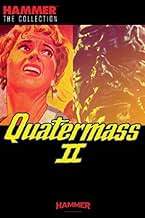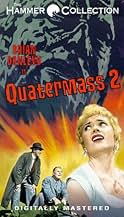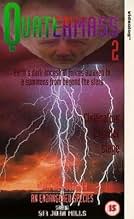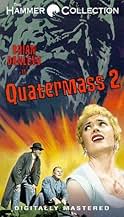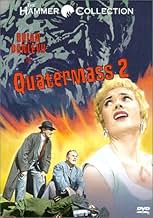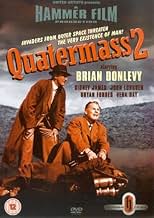IMDb RATING
6.7/10
5.1K
YOUR RATING
Professor Quatermass, trying to gather support for his Lunar colonisation project, is intrigued by mysterious traces that have been showing up.Professor Quatermass, trying to gather support for his Lunar colonisation project, is intrigued by mysterious traces that have been showing up.Professor Quatermass, trying to gather support for his Lunar colonisation project, is intrigued by mysterious traces that have been showing up.
John Longden
- Lomax
- (as John Longdon)
Sidney James
- Jimmy Hall
- (as Sydney James)
Featured reviews
This was one of the first of its kind; a subtlety scary vision of a secret alien takeover. X-FILES may owe a debt to this low-budget, but nevertheless effective film of the powers-that-be who are conspiring with the invaders, and one lone, determined scientist who accidentally uncovers the sinister plot.
QUATERMASS II (U.S. title: ENEMY FROM SPACE) was produced before INVASION OF THE BODY SNATCHERS, the film it is often compared to, due to their thematic similarities (loss of identity, social oppression, dangers of conformity, and blind allegiance to a greatly questionable, authoritarian power). However, it was released in the U.S. shortly after BODY SNATCHERS, probably making it look like a copycat to some.
Superb writer Nigel Kneale (excellent script, highly original for its time, derived from the earlier BBC serial) was known to strongly despise Brian Donleavy's gruff performance as the lead character. Kneale did not like the fact that Donleavy presented the character as a cold, methodical misanthrope who treats his colleagues like expendable underlings. He will probably want to boil me in oil for saying this, but I felt that presenting the lead character as morally ambivalent and ethically questionable jettisoned the standard 50's scientist/hero sterotype (for once he is not nice and charming). It also added a further degree of tension to the well-plotted story. In many ways, his alienated character is somewhat alien; perhaps that's the only true way to resist social pressures and conditioning. The allegory here is strong.
As the story opens, Quatermass is driving one night on a remote country road. He is furious that the stodgy Whitehall bureaucrats rejected his funding request for a proposed moon colonization project. A speeding car nearly hits him head-on as it runs off the road. The shaken passengers are a frightened woman and her boyfriend, who is in a crazed state, and has a strange black mark on his face.
Quatermass returns to his isolated lab, where radar reveals to his assistants that many small meteor particles (at least that's what they assume they are) have descended over a rural village known as Wynerton Flats.
Going out there with his colleague, Marsh, they first discover his moon project, fully constructed, and some small, mysterious rocks. As Marsh examines one, it emits an eerie gas and pops in his face, leaving the weird black mark. Strange soldiers arrive, behaving like aloof zombies, abduct Marsh, strong-arm Quatermass in the typical fascist tradition, and order him to leave. (There may be one flaw here: Why didn't the "soldiers" either abduct or kill Quatermass, instead of letting him go, so he can inform?)
Naturally the authorities all have tight lips about the secret activities at Wynerton Flats, but Quatermass manages to convince a few officials to go out there with him. A government aid (with that strange black mark on his wrist) conducts a formal tour of the plant, where everything seems to be normal. Not so. The small group is indoctrinated by the zombies (who resemble Nazis), but Quatermass manages to escape.
(This scene truly exposes Donleavy's ruthless side: He and a woman are taken into a large dome, but Quatermass flees, leaving the woman behind, without any concern for her fate. Hell, he doesn't even abide by the old fifties hero tradition by risking his life to save the distressed damsel. In many ways Quatermass was an ahead-of-his-time anti-hero. I always felt that this added a disquieting strength to the drama and the severity of the dire situation, but I guess that Kneale will still vehemently disagree).
I'll stop here, but don't worry, the worse is still to come. The sense of growing unease and mounting terror (strong qualities of your finer British Science Fiction at that time) escalates. Be patient, for it does carefully build into a total state of alarm, as Quatermass and the local angered citizens challenge the invaders (who have taken over most of the government and military officials) to a brutal showdown. There is something highly menacing in those domes.
This impressive film is true Science Fiction at its best. It thrills without pandering and is thoughtful to the point of disturbing. You can't trust anyone. Its social and political implications are definitely troubling. This is not for your Lucas and Spielberg crowd, for we're not talking about commercial catering to eight-year-olds. Val Guest directs in a cold, cynical Kubrickian manner, accentuating the high degree of paranoia, and the picture's black & white photography conveys a bleak, creepy mood. (Sorry, no pretty pictures here). The intriguing story takes on true nightmarish proportions.
The few effects won't win any CGI awards (don't forget, computers weren't around then) but the briefly glimpsed monster (in the gothic Lovecraft tradition) is quite sickening. After all, it can manipulate man's dirty politics, you can't get more reprehensible than that.
From the late sixties to the late eighties this film was unavailable to the public, and it was feared to be permanently lost, but it later was released on video and shown occasionally on the Science Fiction Channel. Many notable Science Fiction and Horror authors (I believe that Harlan Ellison and Stephen King were among them) have championed this small, but remarkable early Hammer production. This is the film that many others have "borrowed from." Just a polite way of saying RIPPED-OFF!
For those seeking an intelligent challenge, check it out.
QUATERMASS II (U.S. title: ENEMY FROM SPACE) was produced before INVASION OF THE BODY SNATCHERS, the film it is often compared to, due to their thematic similarities (loss of identity, social oppression, dangers of conformity, and blind allegiance to a greatly questionable, authoritarian power). However, it was released in the U.S. shortly after BODY SNATCHERS, probably making it look like a copycat to some.
Superb writer Nigel Kneale (excellent script, highly original for its time, derived from the earlier BBC serial) was known to strongly despise Brian Donleavy's gruff performance as the lead character. Kneale did not like the fact that Donleavy presented the character as a cold, methodical misanthrope who treats his colleagues like expendable underlings. He will probably want to boil me in oil for saying this, but I felt that presenting the lead character as morally ambivalent and ethically questionable jettisoned the standard 50's scientist/hero sterotype (for once he is not nice and charming). It also added a further degree of tension to the well-plotted story. In many ways, his alienated character is somewhat alien; perhaps that's the only true way to resist social pressures and conditioning. The allegory here is strong.
As the story opens, Quatermass is driving one night on a remote country road. He is furious that the stodgy Whitehall bureaucrats rejected his funding request for a proposed moon colonization project. A speeding car nearly hits him head-on as it runs off the road. The shaken passengers are a frightened woman and her boyfriend, who is in a crazed state, and has a strange black mark on his face.
Quatermass returns to his isolated lab, where radar reveals to his assistants that many small meteor particles (at least that's what they assume they are) have descended over a rural village known as Wynerton Flats.
Going out there with his colleague, Marsh, they first discover his moon project, fully constructed, and some small, mysterious rocks. As Marsh examines one, it emits an eerie gas and pops in his face, leaving the weird black mark. Strange soldiers arrive, behaving like aloof zombies, abduct Marsh, strong-arm Quatermass in the typical fascist tradition, and order him to leave. (There may be one flaw here: Why didn't the "soldiers" either abduct or kill Quatermass, instead of letting him go, so he can inform?)
Naturally the authorities all have tight lips about the secret activities at Wynerton Flats, but Quatermass manages to convince a few officials to go out there with him. A government aid (with that strange black mark on his wrist) conducts a formal tour of the plant, where everything seems to be normal. Not so. The small group is indoctrinated by the zombies (who resemble Nazis), but Quatermass manages to escape.
(This scene truly exposes Donleavy's ruthless side: He and a woman are taken into a large dome, but Quatermass flees, leaving the woman behind, without any concern for her fate. Hell, he doesn't even abide by the old fifties hero tradition by risking his life to save the distressed damsel. In many ways Quatermass was an ahead-of-his-time anti-hero. I always felt that this added a disquieting strength to the drama and the severity of the dire situation, but I guess that Kneale will still vehemently disagree).
I'll stop here, but don't worry, the worse is still to come. The sense of growing unease and mounting terror (strong qualities of your finer British Science Fiction at that time) escalates. Be patient, for it does carefully build into a total state of alarm, as Quatermass and the local angered citizens challenge the invaders (who have taken over most of the government and military officials) to a brutal showdown. There is something highly menacing in those domes.
This impressive film is true Science Fiction at its best. It thrills without pandering and is thoughtful to the point of disturbing. You can't trust anyone. Its social and political implications are definitely troubling. This is not for your Lucas and Spielberg crowd, for we're not talking about commercial catering to eight-year-olds. Val Guest directs in a cold, cynical Kubrickian manner, accentuating the high degree of paranoia, and the picture's black & white photography conveys a bleak, creepy mood. (Sorry, no pretty pictures here). The intriguing story takes on true nightmarish proportions.
The few effects won't win any CGI awards (don't forget, computers weren't around then) but the briefly glimpsed monster (in the gothic Lovecraft tradition) is quite sickening. After all, it can manipulate man's dirty politics, you can't get more reprehensible than that.
From the late sixties to the late eighties this film was unavailable to the public, and it was feared to be permanently lost, but it later was released on video and shown occasionally on the Science Fiction Channel. Many notable Science Fiction and Horror authors (I believe that Harlan Ellison and Stephen King were among them) have championed this small, but remarkable early Hammer production. This is the film that many others have "borrowed from." Just a polite way of saying RIPPED-OFF!
For those seeking an intelligent challenge, check it out.
This movie sees Brian Donleavy reprise the role of Bernard Quatermass,who when the movie opens is not a happy man,the British government having turned down his plans for a Moon colony.Distraction arrives in the form of objects from outer space landing in northern England .On going to investigate he finds a site looking more than a little like the moon project mock up,and to complicate matters his assistant(played by future author/director Bryan Forbes,then in his stalwart character actor mode)is stricken by on coming into contact with the alien substance and is carted away by the guards on the project
Quatermass gains entry to the plant as part of a parliamentary study group who are assured it is a project to manufacture synthetic food.Naturally ,they are being economical with the truth and the plant is the front for an alien invasion
How the intrepid if permanently bad tempered scientist tackles the problem is the root of the movie which still has resonance today in its suggestion of cover up and conspiracy,aliens having infiltrated the government and police(This would explain why British politicians seem determined that we shall be ruled by aliens--the EC!)
The movie makes good use of locations and the alien plant is an old utilities generation plant that looks chilling and strangely futuristic.Donleavy is too much on one note as,but Sid James is effective in a rare straight role as a hard drinking journalist and the rest of the cast are adequate
Special effects are antiquated.What still works are its atmosphere and sense of paranoia regarding our political lords and masters.
Quatermass gains entry to the plant as part of a parliamentary study group who are assured it is a project to manufacture synthetic food.Naturally ,they are being economical with the truth and the plant is the front for an alien invasion
How the intrepid if permanently bad tempered scientist tackles the problem is the root of the movie which still has resonance today in its suggestion of cover up and conspiracy,aliens having infiltrated the government and police(This would explain why British politicians seem determined that we shall be ruled by aliens--the EC!)
The movie makes good use of locations and the alien plant is an old utilities generation plant that looks chilling and strangely futuristic.Donleavy is too much on one note as,but Sid James is effective in a rare straight role as a hard drinking journalist and the rest of the cast are adequate
Special effects are antiquated.What still works are its atmosphere and sense of paranoia regarding our political lords and masters.
The second of the Quatermass films (the first was THE QUATERMASS XPERIMENT, the "X" used to emphasise the adult X-rating the film received on its initial release) was allowed a slightly larger budget and benefited enormously from Nigel Kneale's participation in the screenplay. In this film, at least Brian Donlevy behaves a little more like Quatermass ought to, though I still don't think he was right for the part.
For my money, Quatermass should be a pipe-smoking English boffin with leather patches sewn on the elbows of his jacket. The original character was conceived as a kind of Barnes Wallis type, as portrayed by Michael Redgrave in THE DAM BUSTERS.
The movie is set in a post-war Britain that was a little panicked by the idea of nuclear weapons and even more unsettled by the knowledge that our former allies, The Soviets, had the same weapons and they were pointed at us. This was the climate that gave us Orwell's 1984 and Don Siegel's INVASION OF THE BODY SNATCHERS. Paranoia was out to get us ...
This same atmosphere lasted well into the 1960s and can also be glimpsed in TV shows like THE AVENGERS. This was the era I grew up in, so I speak from personal experience :-)
This movie is one of Hammer's better offerings of the period. Released the same year as CURSE OF FRANKENSTEIN, it more than holds its own against the other, better-known Hammer colour offerings. Indeed, it benefits from its monochrome photography, which brilliantly communicates the austerity of the years immediately following WWII.
Thoroughly recommended, this film will appeal to anyone who can get beyond the admittedly primitive 1950s special effects to be rewarded by the rich and clever story that lies beneath the slightly dodgy veneer ...
For my money, Quatermass should be a pipe-smoking English boffin with leather patches sewn on the elbows of his jacket. The original character was conceived as a kind of Barnes Wallis type, as portrayed by Michael Redgrave in THE DAM BUSTERS.
The movie is set in a post-war Britain that was a little panicked by the idea of nuclear weapons and even more unsettled by the knowledge that our former allies, The Soviets, had the same weapons and they were pointed at us. This was the climate that gave us Orwell's 1984 and Don Siegel's INVASION OF THE BODY SNATCHERS. Paranoia was out to get us ...
This same atmosphere lasted well into the 1960s and can also be glimpsed in TV shows like THE AVENGERS. This was the era I grew up in, so I speak from personal experience :-)
This movie is one of Hammer's better offerings of the period. Released the same year as CURSE OF FRANKENSTEIN, it more than holds its own against the other, better-known Hammer colour offerings. Indeed, it benefits from its monochrome photography, which brilliantly communicates the austerity of the years immediately following WWII.
Thoroughly recommended, this film will appeal to anyone who can get beyond the admittedly primitive 1950s special effects to be rewarded by the rich and clever story that lies beneath the slightly dodgy veneer ...
This film was actually the first sequel to use a number in the title (although it's American title was "Enemy from Space"). Not only was this a cleverly written film, based on Nigel Kneale's screenplay, but it was a cruel satire on English and American culture in the 1950s.
In a nutshell, Professor Bernard Quatermass, leader of England's rocket group, is at wit's end trying to get more funding for his projected moon project. The British government decides it has "projects of far greater importance.'' At the same time, workers at Quatermass' base detect scores of what look like meteorites falling close by. When Quatermass investigates, he not only finds remnants of the meteorites, but his moon base, conveniently appropriated by an unknown government entity. His lab assistant picks up one of the meteorites and it explodes in his face, immediately infecting him with an alien parasite.
Quatermass is forced to go it almost alone, helped by a cynical police inspector, a drunken beat reporter and a vigilant member of parliament who can't get even his own party members to question where millions of pounds of tax dollars are going to.
The cruel satire comes from the comparison of Western governments of the 1950s to the communist governments they vehemently opposed during the Cold War years. British citizens were taught to implicitly trust government even as it spent millions to unknowingly fund an alien invasion. Civilian workers were so glad to have jobs they don't question why the supposed "synthetic food" plant they're building needs huge doses of toxic gases like ammonia. Even when evidence of wrongdoing is brought up, government red tape squelches it.
As for the movie itself, it is much better written than the original ("The Quatermass Experiment"). Nigel Kneale softens Quatermass' dour and brusk personality. Director Val Guest effectively uses a string musical score to build a creepy atmosphere. He and Kneale even overcome the first movie's dull ending, which had an alien getting electrocuted with no suspense whatsoever. Here, the plant workers, angry that one of their own is carted away by infected security guards at gunpoint, try to storm the plant, turning the aliens' carefully planned invasion on its ear. The irony, of course, is that the plant was conceived because government bureaucracy kept it secret. Now, as the plant is threatened, the same secrecy prevents the aliens from calling for help from the police or armed forces.
The special effects are better in this film, though the giant aliens at the end are not as convincing as they could be. Still, the film is a great example of British science fiction, which relied more on plot and characterization than the special effects that dominated American science fiction.
In a nutshell, Professor Bernard Quatermass, leader of England's rocket group, is at wit's end trying to get more funding for his projected moon project. The British government decides it has "projects of far greater importance.'' At the same time, workers at Quatermass' base detect scores of what look like meteorites falling close by. When Quatermass investigates, he not only finds remnants of the meteorites, but his moon base, conveniently appropriated by an unknown government entity. His lab assistant picks up one of the meteorites and it explodes in his face, immediately infecting him with an alien parasite.
Quatermass is forced to go it almost alone, helped by a cynical police inspector, a drunken beat reporter and a vigilant member of parliament who can't get even his own party members to question where millions of pounds of tax dollars are going to.
The cruel satire comes from the comparison of Western governments of the 1950s to the communist governments they vehemently opposed during the Cold War years. British citizens were taught to implicitly trust government even as it spent millions to unknowingly fund an alien invasion. Civilian workers were so glad to have jobs they don't question why the supposed "synthetic food" plant they're building needs huge doses of toxic gases like ammonia. Even when evidence of wrongdoing is brought up, government red tape squelches it.
As for the movie itself, it is much better written than the original ("The Quatermass Experiment"). Nigel Kneale softens Quatermass' dour and brusk personality. Director Val Guest effectively uses a string musical score to build a creepy atmosphere. He and Kneale even overcome the first movie's dull ending, which had an alien getting electrocuted with no suspense whatsoever. Here, the plant workers, angry that one of their own is carted away by infected security guards at gunpoint, try to storm the plant, turning the aliens' carefully planned invasion on its ear. The irony, of course, is that the plant was conceived because government bureaucracy kept it secret. Now, as the plant is threatened, the same secrecy prevents the aliens from calling for help from the police or armed forces.
The special effects are better in this film, though the giant aliens at the end are not as convincing as they could be. Still, the film is a great example of British science fiction, which relied more on plot and characterization than the special effects that dominated American science fiction.
I first saw this film once when I was about five or six years old on TV. Because the film had location shooting at an oil refinery, for years I was always reminded of this film when ever I drove past one, wondering if something sinister was going on inside those tanks. However, soon after I first saw this film, QUATERMASS 2 (or ENEMY FROM SPACE-as it was called here in the USA), was pulled from distribution for various legal reasons, and this film was for years impossible to view. Then the film was released from its legal limbo in the mid eighties and I purchased a video copy as soon as it came out.
Unlike so many hard to view films that have been promoted as "a long lost classic", that often turn out not to live up to their reputations when finally viewed again*, QUATERMASS 2 truly deserves its reputation as a rediscovered lost classic. It is one of the best British science fictions films from the fifties.
The films acting and direction are uniformly good. The black and white photography is excellent and the film has an excellent musical score (although sometimes the music is a bit too loud.) The scene where the giant aliens burst from the domes is one of my favorite scenes in a fantastic film. Its like something out of a nightmare: the dome begins to crack, like a giant egg, and emerging from is not a cute little chick, but a hideous malignancy. The gloomy dark gray lighting enhance this scene. However, the aliens that emerge, while gross and repulsive looking when viewed for the first time, begin to look a tad bit silly after repeated viewings.
Perhaps one of the most interesting thing about this film when viewed today, is the films story has many similarities to the "Area 51" mythology. In the film there is government owned plant where everything is top secret, it gets unlimited tax payer funding, but no one in the government dare asks whats going on. This sounds lot like what we are told about the so-called "Area 51." I'm surprised " psycho/social reductionists" like Curtis "Watch The Skies" Peebles overlooked this film. Then again, maybe we are lucky they have.
QUATERMASS 2 is an excellent fifties science fiction that should be more widely shown. Like the other films in the famous "Quatermass" series, its literate, suspenseful and thrilling.
*Sometimes the films promoted as "long lost classics" aren't even lost!
Unlike so many hard to view films that have been promoted as "a long lost classic", that often turn out not to live up to their reputations when finally viewed again*, QUATERMASS 2 truly deserves its reputation as a rediscovered lost classic. It is one of the best British science fictions films from the fifties.
The films acting and direction are uniformly good. The black and white photography is excellent and the film has an excellent musical score (although sometimes the music is a bit too loud.) The scene where the giant aliens burst from the domes is one of my favorite scenes in a fantastic film. Its like something out of a nightmare: the dome begins to crack, like a giant egg, and emerging from is not a cute little chick, but a hideous malignancy. The gloomy dark gray lighting enhance this scene. However, the aliens that emerge, while gross and repulsive looking when viewed for the first time, begin to look a tad bit silly after repeated viewings.
Perhaps one of the most interesting thing about this film when viewed today, is the films story has many similarities to the "Area 51" mythology. In the film there is government owned plant where everything is top secret, it gets unlimited tax payer funding, but no one in the government dare asks whats going on. This sounds lot like what we are told about the so-called "Area 51." I'm surprised " psycho/social reductionists" like Curtis "Watch The Skies" Peebles overlooked this film. Then again, maybe we are lucky they have.
QUATERMASS 2 is an excellent fifties science fiction that should be more widely shown. Like the other films in the famous "Quatermass" series, its literate, suspenseful and thrilling.
*Sometimes the films promoted as "long lost classics" aren't even lost!
Did you know
- TriviaThis is believed to be the first film ever to use the arabic numeral 2 as an indicator that it was the sequel to another film (as opposed to Roman numerals).
- GoofsWhen hurrying to the phone in the Pressure Control Block, McLeod puts down his jacket, which slips to the floor. It appears to have returned to where he originally placed it when he retrieves it in another shot, however.
- Quotes
Quatermass: They tell me you have no police here?
Dawson: Police? We don't need them - we're a law-abiding community, aren't we?
- ConnectionsFeatured in The Saturday Afternoon Movie: Enemy From Space (1966)
- How long is Quatermass 2?Powered by Alexa
Details
Box office
- Budget
- £92,000 (estimated)
- Gross worldwide
- $77
- Runtime
- 1h 25m(85 min)
- Color
Contribute to this page
Suggest an edit or add missing content


